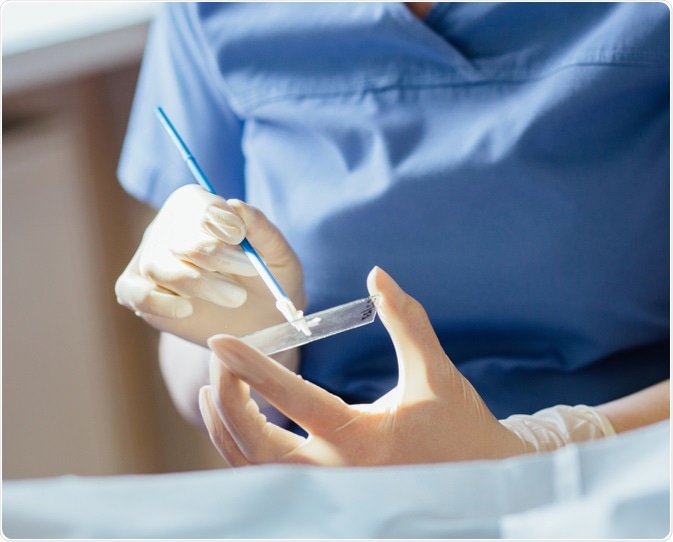A new method of cervical cancer screening which is designed to be done by women at home could bring down the rates of cervical cancer and associated deaths. The work, presented at the National Cancer Research Institute (NCRI) Conference 2019 in Glasgow, has attracted immense attention because of its feasibility and wide acceptance.

Women need to have a cervical screening test every five years from the age of 25. The Pap smear, also called a Pap test, is a procedure performed at a GP surgery to test for cervical cancer in women. Image Credit: Iryna Inshyna / Shutterstock
Cervical cancer is among the most deadly cancers in women, and in many cases it is due to infection with certain high-risk strains of the human papilloma virus (HPV). For this reason, HPV screening is a top-priority intervention among women of reproductive age, in order to detect women who are at higher risk for cancer of the cervix. The current testing methods are extremely sensitive but specificity is relatively limited, making a second round of differentiation necessary. At present, cervical smears taken by a doctor are the gold standard for screening in HPV+ women.
In the UK, the National Health Service (NHS) calls in all women between the age of 25 and 64 years for a cervical screening, but the response rates have been dwindling, leaving out about a quarter of all eligible women. This is a great pity, as cervical screening is meant to pick up early changes in the cervix that could herald the beginnings of a cancerous change, but are not cancerous in any sense and could be completely treated.
Reasons for the low rate of cervical smear screening include embarrassment, not realizing its importance, or plain old procrastination.
The study
The current study aims to replace that by a test for early precancerous change, which is called cervical intraepithelial neoplasia (CIN) grade 2 and above. The key change tested for is high levels of DNA methylation. The test uses the S5 methylation classifier at target regions of the HPV strains HPV16, HPV18, HPV31, HPV33, and a human gene, namely, EPB41L3.
The classifier test was performed on 2 sets of specimens which could be collected noninvasively from women who came in for colposcopy at the Royal London Hospital due to a prior abnormal cytology screening or HPV positivity. There were 503 women who gave urine samples and 600 who self-collected vaginal samples using provided tools.
The researchers extracted DNA from the samples and analyzed it to calculate the average methylation.
The findings
The S5 classifier was able to differentiate normal and CIN1 samples from those with CIN2+, for both urine and vaginal self-swab samples. The sensitivity was 66% with urine samples and 71% for vaginal samples. The specificity was 72% and 68% respectively. These figures are lower than those achieved by the current cervical smear program in the UK. However, the researchers are confident that this is only a proof of concept, and they say it will be soon as effective as the official program. Says researcher Belinda Nedjai, “It will be soon. With improvement we'll get there.”
Conclusion
The researchers say, “We demonstrated that S5 can be successfully amplified in urine and vaginal self-collected samples and that the classifier is able to correctly identify CIN2+ women.” The advantages of a DIY kit are obvious: more HPV positive women will test themselves, perhaps repeatedly, thus enhancing the chances of picking up more cervical cancers at an early stage, when they are potentially curable. It would also save doctor time since it is based on self-testing.
Many organizations welcomed these findings, calling the research a possible “game-changer”. Jo's Cervical Cancer Trust executive Robert Music explained: “It could mean those requiring treatment are identified faster and reduce the number of women having to go for potentially unnecessary investigations at colposcopy.”
The new test, if validated and improved, can reduce costs and enhance accuracy, as well as boost acceptance rates for cervical cancer screening. However, the S5 test must be subjected to clinical trials in much larger numbers to gauge its true effectiveness. At least 10 000 women must be tested before the NHS can even think of offering it, says Nedjai.
Moreover, it will probably not obviate cervical smears, which will probably still continue to be done. However, it offers great promise to reach those women who can’t or won’t meet their doctors for a cervical screening test. She says that within five years this test could be offered via the NHS to be done at home.
It could be done along with conventional screening procedures, to enhance detection sensitivity and prevent unnecessary follow-up testing in some women. At present, the NHS is shifting to offering HPV screening of cervical samples, to look for the presence of the virus in cervical cells. Cell cytology to look for abnormalities in cervical cells indicative of cancer will be done only if the woman is HPV positive. This is based on the realization that almost every cervical cancer is because of HPV infection.
Another researcher, Manuel Rodriguez-Justo, sums up the implications: “This is exciting research that shows it's possible to detect cervical pre-cancer that is at high risk of developing into invasive cancer in urine and vaginal samples collected by women in the comfort and privacy of their own homes. This has the potential to revolutionize the way a positive HPV test is followed up, as well as making it easier for women in countries with no cervical cancer screening program to be tested."
Journal reference:
Abstracts from the NCRI Cancer Conferences (2019). Non-invasive methylation test to detect cervical pre-cancer in self-collected vaginal and urine specimens. Belinda Nedjai, Caroline Reuter, Toni Hollingworth, Janet Austin, Louise Cadman, Jack Cuzick, and Attila Lorincz. https://abstracts.ncri.org.uk/abstract/non-invasive-methylation-test-to-detect-cervical-pre-cancer-in-self-collected-vaginal-and-urine-specimens/